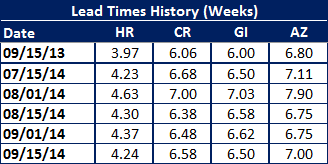SMU Data and Models

Steel Mill Lead Times Better Than This Time Last Year
Written by John Packard
September 21, 2014
Based on the results from our most recent Steel Market Update steel market analysis, flat rolled steel mill lead times, the number of weeks needed to produce and ship a new order, remained above 2013 levels on all products.
SMU conducted one of our twice monthly steel market surveys this past week. During the process we asked those responding to our online invitation to participate where they were seeing lead times for new orders placed with the domestic steel mills.
The participants, which are all either manufacturing companies or flat rolled steel service centers reported hot rolled lead times as remaining above 4 weeks (as an average) where they have been for most of this year. Last year at this time they were reported to average 3.97 weeks.
Cold rolled lead times averaged 6.58 weeks based on this week’s survey results which is approximately one half week longer than one year ago. Galvanized was in a similar situation with it hovering around the 6.50 week mark for four of the last five survey periods while last year it was measured at 6.00 weeks.
Galvalume lead times increased to 7.00 weeks which is close to the 6.80 weeks reported last year at this time.
The consistency of lead times has been one of the factors which has held prices relatively stable during calendar year 2014.
An interactive graphic can be seen below when you are reading the newsletter online. If you have not logged into the website in the past and need your username and password, contact us at: info@SteelMarketUpdate.com or by calling 800-432-3475. If you need help navigating the website we would also be very happy to assist you.
{amchart id=”112″ SMU Lead Times by Product- Survey}

John Packard
Read more from John PackardLatest in SMU Data and Models

SMU Survey: Buyers’ Sentiment rebounds from multi-year low
Both of SMU’s Steel Buyers’ Sentiment Indices edged higher this week. Current Sentiment rebounded from a near five-year low, while Future Sentiment rose to a two-month high

SMU flat-rolled market survey results now available
SMU’s latest steel buyers market survey results are now available on our website to all premium members.

SMU Survey: Sheet lead times pull back after early-June blip, plate holds
Following the uptick seen two weeks ago, lead times eased this week for all four sheet products tracked by SMU, while plate lead times held steady, according to this week’s market survey.

SMU Survey: Pricing power abruptly shifts to steel buyers
The majority of steel buyers responding to our latest market survey say domestic mills are more willing to talk price on sheet and plate products than they were earlier this month. Sheet negotiation rates rebounded across the board compared to early June, while our plate negotiation rate hit a full 100%.

Service centers: Mill orders down marginally in May
SMU’s Mill Order Index (MOI) declined for a third straight month in May, but only marginally.

